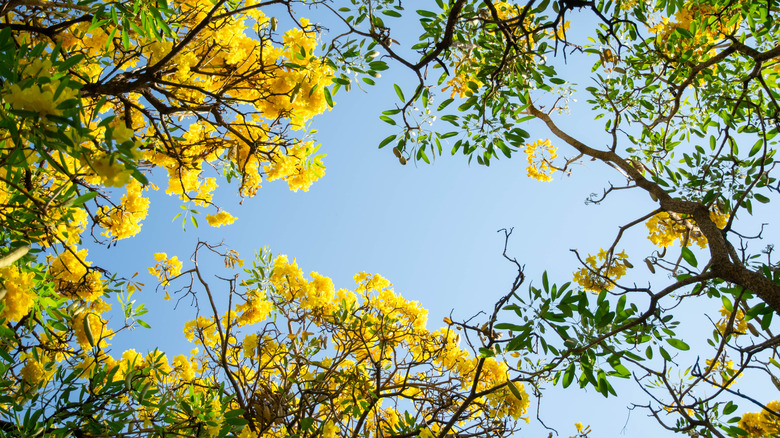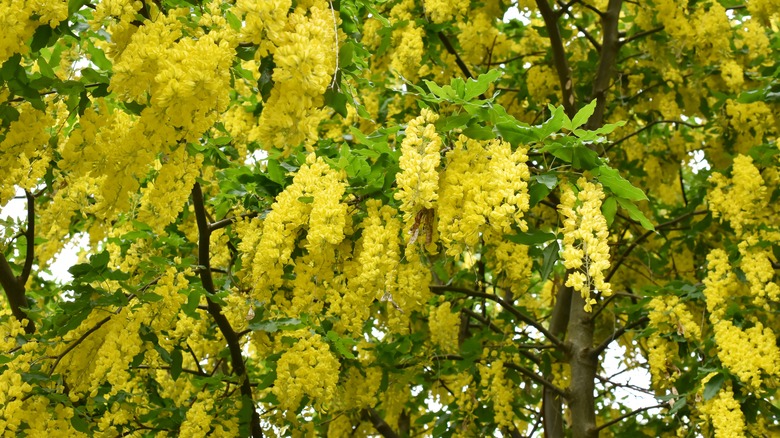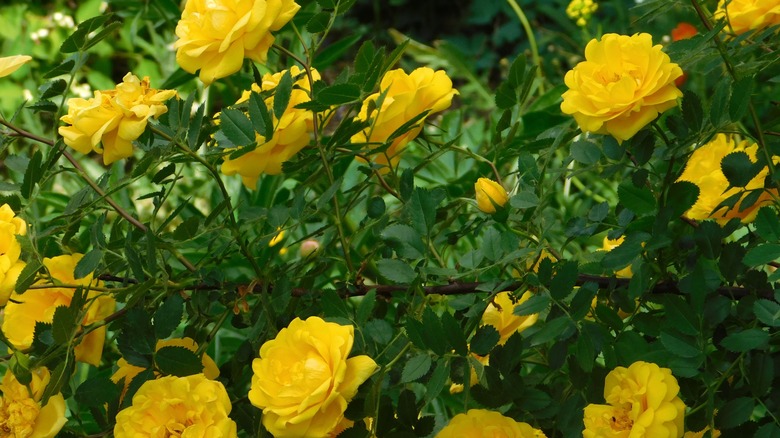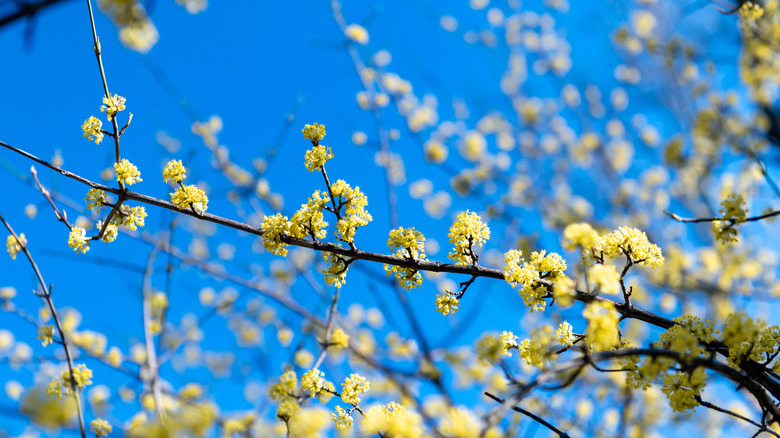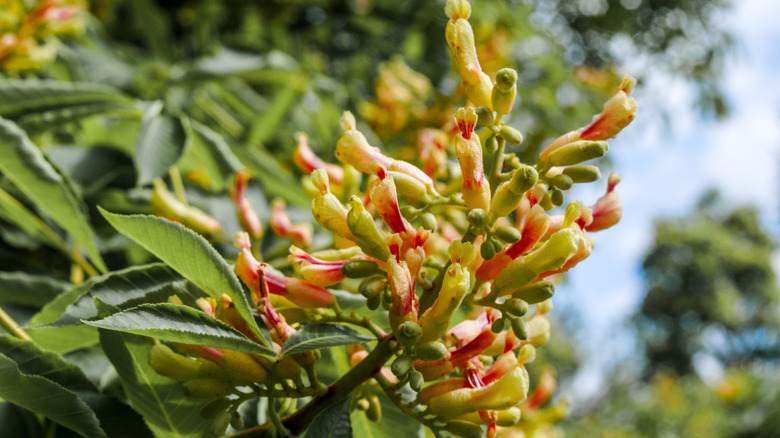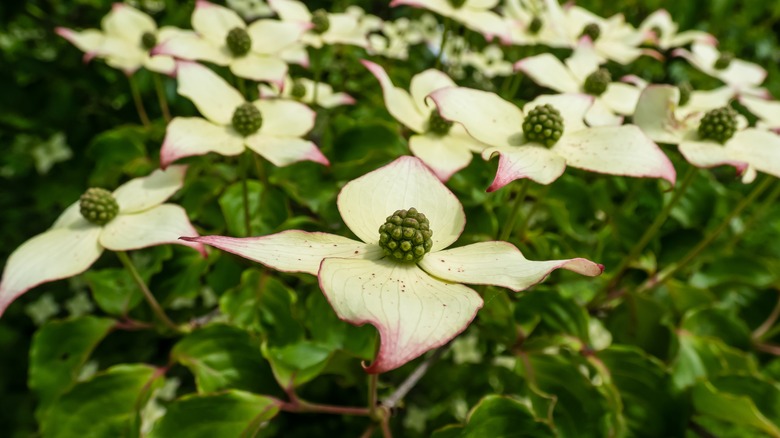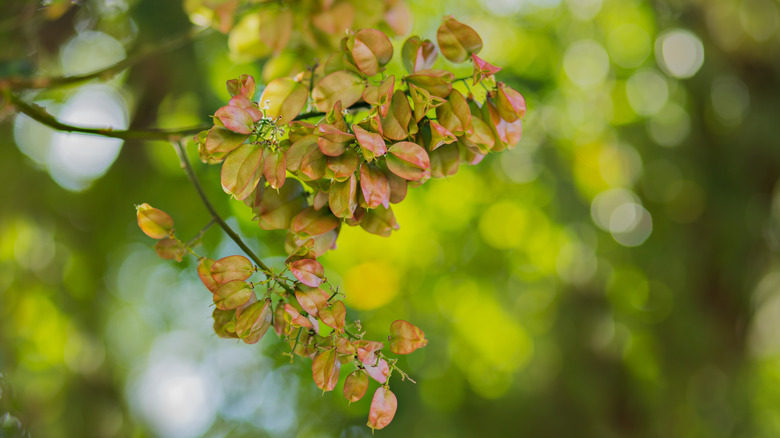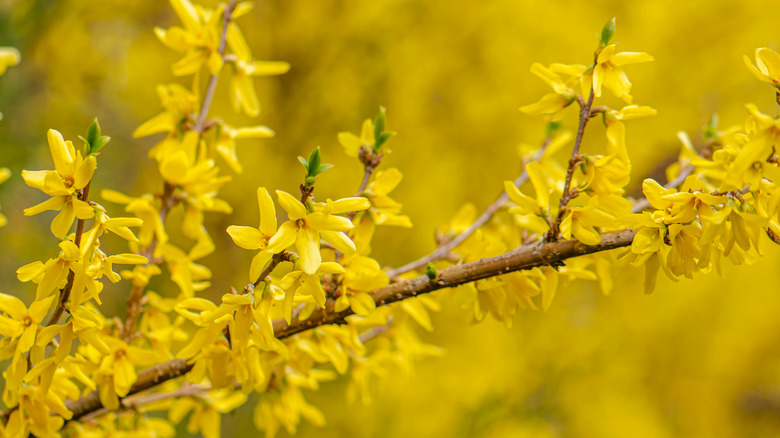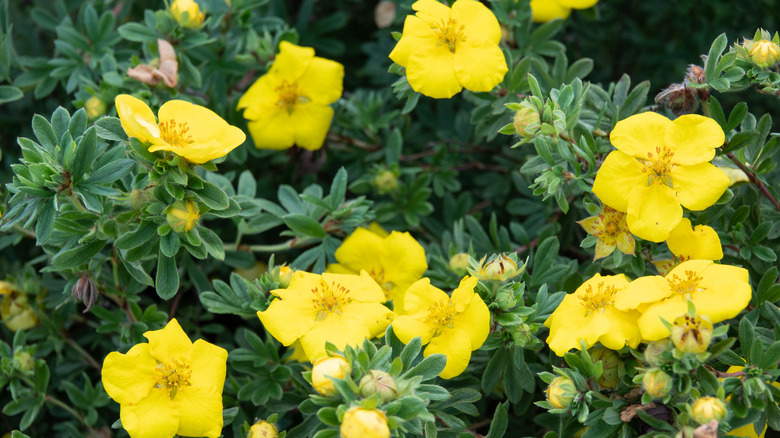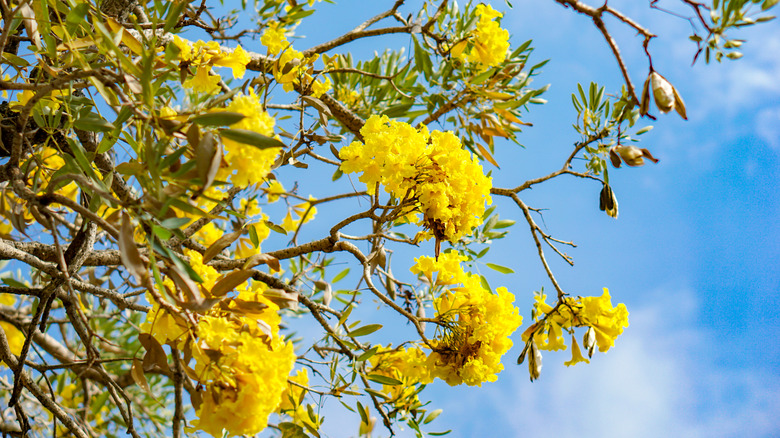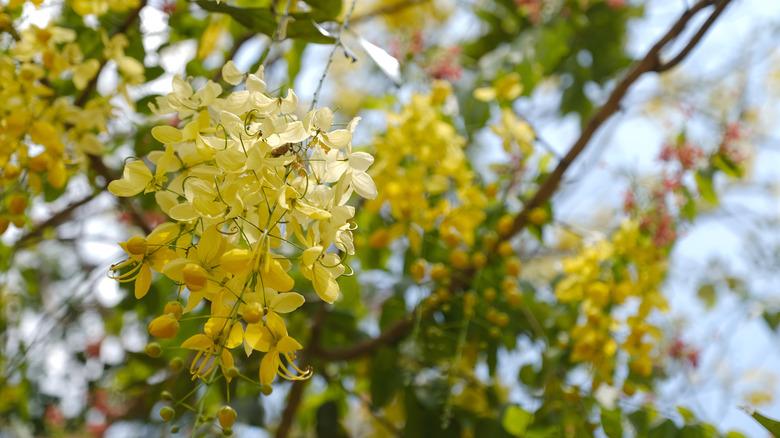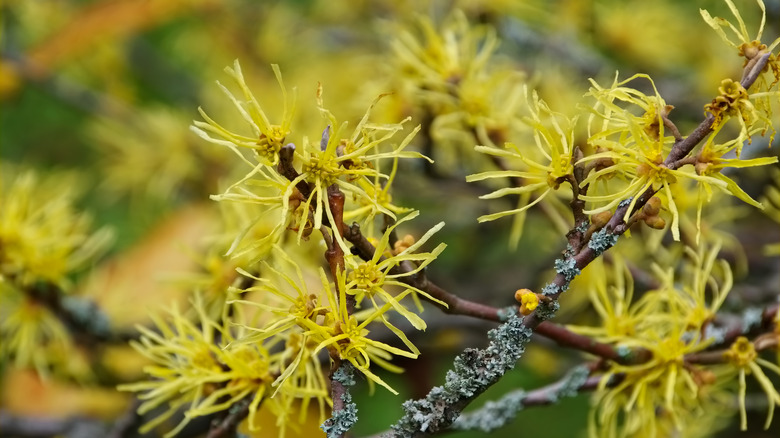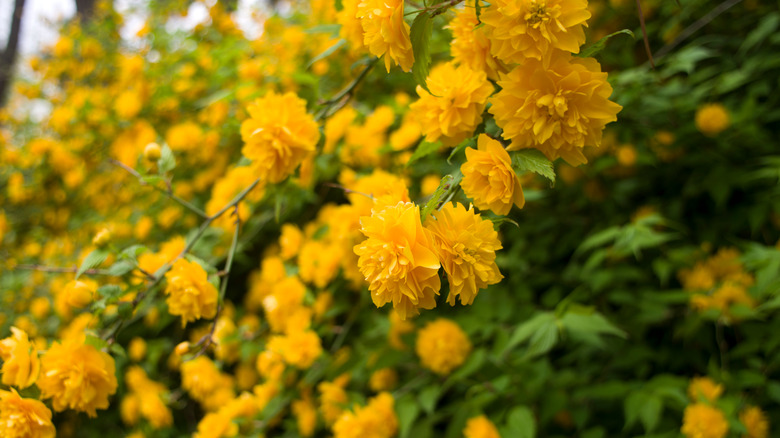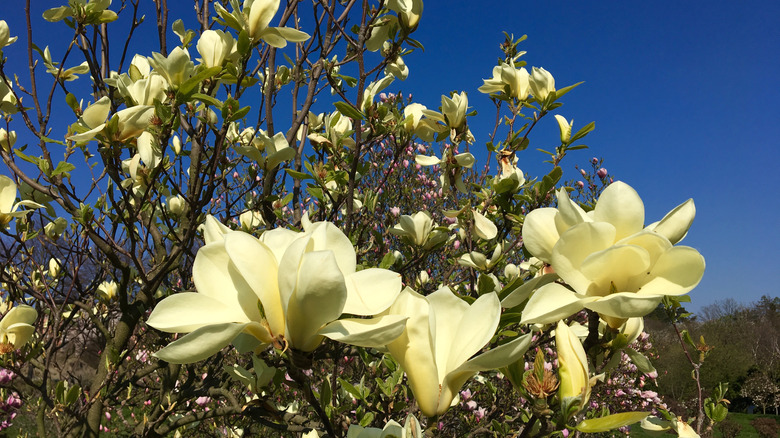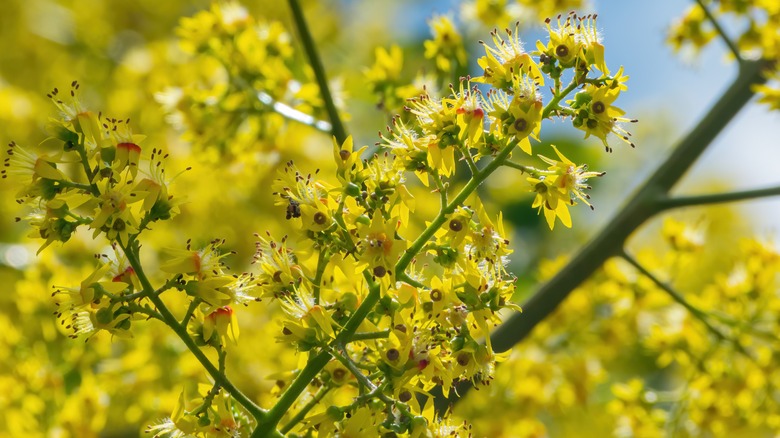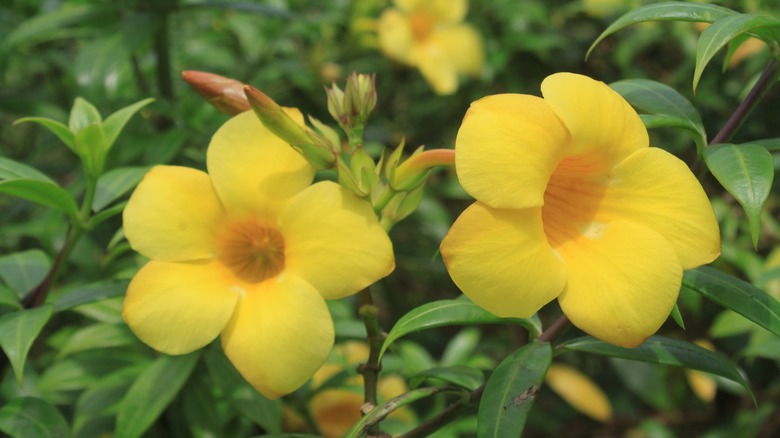15 Trees That Bloom With Gorgeous Yellow Flowers
You don't need a good reason to plant a tree. Yet, you'll find so many benefits when you do. Trees, as you probably learned in school, fight climate change, absorb CO2, produce oxygen, attract birds, and even increase the value of your home, according to the Arbor Day Foundation. Flowering trees, such as the ones we are about to describe, also attract pollinators like hummingbirds, bees, and butterflies, and they bring forth a cheery display of color during their bloom season.
Yellow trees, in particular, will help to brighten your garden with a brilliant display of color. Contrasting with green foliage, the flowers on these trees pop as they mimic the warm sun. Before you make a decision, be sure to check your USDA zone and the height of your favorite tree. With the right conditions, you may grow a spectacular specimen that will highlight your landscape for many years to come.
1. Golden chain tree
The golden chain tree (Laburnum anagyroides) is a low-maintenance tree that shows off gorgeous pea-shaped blossoms that hang down as heavily flowered stalks, as told by RHS. It may take up to 20 years before these trees reach their mature height, however, they are still very beautiful when they are young.
Bloom Season: Spring and summer
USDA Growing Zone: 5 to 11
Growing Conditions: Full sun
Soil Type: Well-drained chalk, sand, clay, or loam
Size: 15 to 25 feet tall
2. Julia Child rose tree
The Julia Child rose tree (Floribunda Rose 'Julia Child') is a flowering shrub that won't take over your yard. It produces large yellow flowers that measure about 4 inches across and smell delicious, as described by Gardenia. This plant requires average maintenance, and it allows you to take excellent cuttings.
Bloom Season: Late spring to fall
USDA Growing Zone: 5 to 10
Growing Conditions: Full sun
Soil Type: Well-drained chalk, sand, clay, or loam
Size: 2 to 3 feet tall
3. Cornelian cherry dogwood
Cornelian cherry dogwood trees (Cornus mas) are known for their small stature, yellow flowers, and edible fruit, according to Missouri Botanical Garden. They are native to western Asia and Europe, where they perform well in cooler climates with little maintenance. Though this tree isn't as pretty as other Cornus species, it is loved for its fruit called "Cornelian cherries," which turn red at the end of summer.
Bloom Season: Spring
USDA Growing Zone: 4 to 8
Growing Conditions: Full sun to partial shade
Soil Type: Average and well-drained
Size: 15 to 25 feet tall
4. Yellow buckeye
Yellow buckeye trees (Aesculus flava) are well-known for their yellow blossoms and their seeds that look like brown deer eyes, as explained by the Arbor Day Foundation. In urban conditions, this plant requires little maintenance, and it doesn't harbor many pests. It can be grown ornamentally, or you can use it to shade your yard, patio, and home.
Bloom Season: Spring or summer
USDA Growing Zone: 4 to 8
Growing Conditions: Full sun
Soil Type: Well-drained, acidic, moist, loamy, sandy, or clay soils
Size: 60 to 75 feet tall
5. Kousa dogwood
Kousa dogwood (Cornus kousa) is also called Chinese dogwood because it is native to several parts of China, including north-central China, south-central China, and southeastern China, as explained by North Carolina State Extension. This tree has year-round interest as it blooms in the spring, produces berries in the fall, and its leaves change color just before winter.
Bloom Season: Spring
USDA Growing Zone: 5 to 8
Growing Conditions: Full sun to partial shade
Soil Type: Well-draining and acidic
Size: 20 to 30 feet tall
6. Chinese flame tree
The Chinese flame tree (Koelreuteria bipinnata) is one of three species in the Koelreuteria genus, according to UFEI. Native to southwestern China, the tree produces fragrant yellow flowers with orange centers and four petals. This plant can also be identified by its oval leaves and tan, papery fruit.
Bloom Season: Summer and fall
USDA Growing Zone: 7 to 9
Growing Conditions: Full sun to partial shade
Soil Type: Well-drained sand, clay, or loam
Size: 40 feet tall
7. Golden bells tree
Forsythia (Forsythia x intermedia) is also called golden bells. An artificial hybrid, this tree tolerates drought and pollution in urban climates, says North Carolina State Extension. Though they grow smaller than most trees, golden bells grow quickly and they bloom early in the spring.
Bloom Season: Early spring
USDA Growing Zone: 6 to 8
Growing Conditions: Full sun and partial shade
Soil Type: Well-drained sand, clay, or loam
Size: 8 to 10 feet tall
8. Bush cinquefoil
Bush cinquefoil (Dasiphora fruticosa) can be referred to as shrubby cinquefoil, as per Oregon State University. This small tree, which usually displays gorgeous yellow blossoms in the early springtime, can also produce flowers in pink, white, or red. If you are not a fan of this plant's tree-like growth habit, you can prune it into hedges or other shapes.
Bloom Season: Early spring
USDA Growing Zone: 2 to 7
Growing Conditions: Full sun to partial shade
Soil Type: Well-drained
Size: 2 to 4 feet tall
9. Yellow tabebuia
Yellow tabebuia (Tabebuia rosea) is a fairly common street tree and shade tree in its native areas of Venezuela, Mexico, Ecuador, and Columbia, as explained by Missouri Botanical Garden. These tall-growing trees often show off rose to lavender-colored blossoms, but yellow tabebuia blossoms with bright yellow trumpet-shaped flowers.
Bloom Season: Blooms at various times throughout the year
USDA Growing Zone: 9 to 11
Growing Conditions: Full sun
Soil Type: Well-drained deep, fertile, and moist
Size: 60 to 90 feet tall, shorter in cultivation
10. Golden shower tree
The golden shower tree (Cassia fistula) is a heat and sun-loving tree that is commonly grown in warm climates as freezing temperatures will kill it. According to the University of Florida, this fast-growing tree is easily recognized by its clusters of yellow flowers and elliptic alternate leaves.
Bloom Season: Spring and summer
USDA Growing Zone: 10 to 11
Growing Conditions: Full sun
Soil Type: Well-drained sand, clay, or loam
Size: 30 to 40 feet tall
11. Witch hazel
Witch hazel (Hamamelis virginiana) is a well-known multi-stemmed shrub that presents small, fragrant yellow flowers from October to December, as mentioned by the University of Minnesota. Its leaves are loved for their large oval shape and their golden-yellow color in the fall. Though this tree-like plant can grow quite tall, it does well as a border plant, a hedge, or it can be used as screening.
Bloom Season: Winter and fall
USDA Growing Zone: 3 to 8
Growing Conditions: Full sun or partial shade
Soil Type: Organically rich, moist, and well-draining
Size: 15 to 25 feet tall
12. Japanese rose
The Japanese rose tree (Kerria japonica) is actually a deciduous shrub known for its early flowering, as said by Clemson Cooperative Extension. It produces yellow flowers with five petals that look just like roses in their double-flowering form. When this small tree is not in bloom, it is decorated with birch-like leaves that are bright green in the summer and pinkish in the fall.
Bloom Season: Early spring
USDA Growing Zone: 4 to 9
Growing Conditions: Partial shade
Size: 3 to 8 feet tall
13. Magnolia 'Butterflies' tree
The Magnolia 'Butterflies' tree (M. acuminata x M. denudata) is a gorgeous specimen plant that is grown for its yellow tulip-shaped blossoms that smell like lemons, as explained by RHS. These flowers bloom profusely all over the tree until you can hardly see its branches. Even when the tree isn't in blossom, its bark and foliage are attractive and look great in several types of gardens.
Bloom Season: Spring
USDA Growing Zone: 5 to 9
Growing Conditions: Full sun to partial shade
Soil Type: Well-drained sand, clay, or loam
Size: 25 to 30 feet tall
14. Golden raintree
The golden raintree (Koelreuteria paniculata) is related to the Chinese flame tree. It is commonly grown in California as well as in its native regions of China, Japan, and Korea where it is regarded for its yellow flowers that can be used medicinally or to make dye, as per UFEI.
Bloom Season: Summer
USDA Growing Zone: 6 to 9
Growing Conditions: Full sun to partial shade
Soil Type: Sand, clay, or loam
Size: 25 to 35 feet tall
15. Golden trumpet
The golden trumpet tree (Allamanda cathartica) is named after its blossoms that are bright yellow and trumpet-shaped. What their name doesn't mention is that they also have a delightful, fresh floral scent. As described by the University of Wisconsin-Madison, golden trumpet trees are most often characterized by their leathery leaves, high humidity requirements, and tall climbing habit.
Bloom Season: Summer and fall
USDA Growing Zone: 10 to 11
Growing Conditions: Full sun
Soil Type: Rich and well-drained
Size: 15 feet tall
